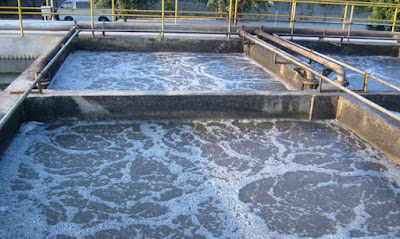SPONSORED
Introduction of Wastewater Treatment

Conventional wastewater treatment consists of a combination of physical, chemical, and biological processes It operations to remove solids, organic matter and, sometimes, nutrients from wastewater. In some countries, disinfection to remove pathogens sometimes follows the last treatment step.
Objectives of wastewater treatment
One of the principle objectives of wastewater treatment is to prevent as much of this "oxygen-demanding" organic material as possible. Other objectives of wastewater treatment include, removal of objectionable items, nutrients and heavy metals.
Conventional wastewater treatment - Overview
Conventional wastewater treatment can be divided into primary,secondary,and tertiary treatment.
1. Primary Treatment.
Primary treatment involves Screening (to remove large objects), Grit chamber (slows down the flow to allow grit to fall out), Primary sedimentation tank (settleable solids settle out, while oils float to the top and are skimmed off).
Screening is the first technique employed in the wastewater treatment process. This step removes all sorts of refuse that has arrived with the wastewater such as plastic, branches, rags, and metals. The screening process is used primarily to prevent the clogging and interference of the following wastewater treatment processes.
The purpose of grit removal is to remove the heavy inorganic solids, which could cause excessive mechanical wear. Grit includes sand, gravel, clay, egg shells, coffee grounds, metal filings, seeds and other similar materials.

Many oils can be recovered from open water surfaces by skimming devices - which is designed to separate the oil and suspended solids from their wastewater effluents. However, hydraulic oils and the majority of oils that have degraded to any extent will also have a soluble or emulsified component that will require further treatment to eliminate.
Sedimentation simply entails the physical settling of matter, due to its density, buoyancy, and the force of gravity. Most of the suspended solids in wastewater are sticky in nature and flocculate naturally which is settling without the addition of coagulants.
Through sedimentation, the larger solids are removed in order to facilitate the efficiency of the following procedures. The tank is large enough that fecal solids can settle. Scum removal is accomplished by having sludge scrappers.

After primary treatment process, nearly 50- 70% of the solids settle down under influence of gravity and 25% – 55 % of the incoming BOD are removed. But colloidal and dissolved constitutes are not affected. Continue with the secondary treatment.
2. Secondary Treatment
Typically utilize biological treatment processes, in which microorganisms convert non-settleable solids to settleable solids. Provide BOD removal beyond what is achieved in primary treatment. Will be discussing more on this in next post.
3. Sludge Treatment and Disposal
Advanced level of treatment to remove constituents of concern including nutrients, toxic compounds, and increased amounts of organic matter and suspended solids. This level of treatment is utilized when the effluent is discharged to a sensitive receiving environment or in water reuse applications. The process can be accomplished using a variety of physical, chemical, or biological treatment processes to remove targeted pollutants. Will be discussing more on this in next post.

Conventional wastewater treatment consists of a combination of physical, chemical, and biological processes It operations to remove solids, organic matter and, sometimes, nutrients from wastewater. In some countries, disinfection to remove pathogens sometimes follows the last treatment step.
Objectives of wastewater treatment
One of the principle objectives of wastewater treatment is to prevent as much of this "oxygen-demanding" organic material as possible. Other objectives of wastewater treatment include, removal of objectionable items, nutrients and heavy metals.
Conventional wastewater treatment - Overview
Conventional wastewater treatment can be divided into primary,secondary,and tertiary treatment.
1. Primary Treatment.
Primary treatment involves Screening (to remove large objects), Grit chamber (slows down the flow to allow grit to fall out), Primary sedimentation tank (settleable solids settle out, while oils float to the top and are skimmed off).
Screening is the first technique employed in the wastewater treatment process. This step removes all sorts of refuse that has arrived with the wastewater such as plastic, branches, rags, and metals. The screening process is used primarily to prevent the clogging and interference of the following wastewater treatment processes.
The purpose of grit removal is to remove the heavy inorganic solids, which could cause excessive mechanical wear. Grit includes sand, gravel, clay, egg shells, coffee grounds, metal filings, seeds and other similar materials.

Many oils can be recovered from open water surfaces by skimming devices - which is designed to separate the oil and suspended solids from their wastewater effluents. However, hydraulic oils and the majority of oils that have degraded to any extent will also have a soluble or emulsified component that will require further treatment to eliminate.
Sedimentation simply entails the physical settling of matter, due to its density, buoyancy, and the force of gravity. Most of the suspended solids in wastewater are sticky in nature and flocculate naturally which is settling without the addition of coagulants.
Through sedimentation, the larger solids are removed in order to facilitate the efficiency of the following procedures. The tank is large enough that fecal solids can settle. Scum removal is accomplished by having sludge scrappers.

After primary treatment process, nearly 50- 70% of the solids settle down under influence of gravity and 25% – 55 % of the incoming BOD are removed. But colloidal and dissolved constitutes are not affected. Continue with the secondary treatment.
2. Secondary Treatment
Typically utilize biological treatment processes, in which microorganisms convert non-settleable solids to settleable solids. Provide BOD removal beyond what is achieved in primary treatment. Will be discussing more on this in next post.
3. Sludge Treatment and Disposal
Advanced level of treatment to remove constituents of concern including nutrients, toxic compounds, and increased amounts of organic matter and suspended solids. This level of treatment is utilized when the effluent is discharged to a sensitive receiving environment or in water reuse applications. The process can be accomplished using a variety of physical, chemical, or biological treatment processes to remove targeted pollutants. Will be discussing more on this in next post.



